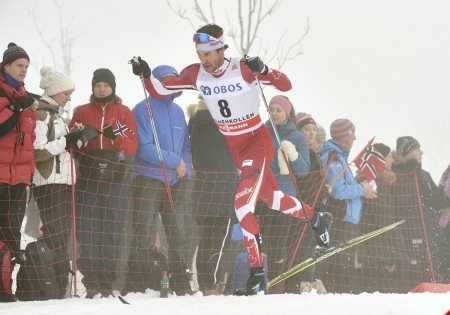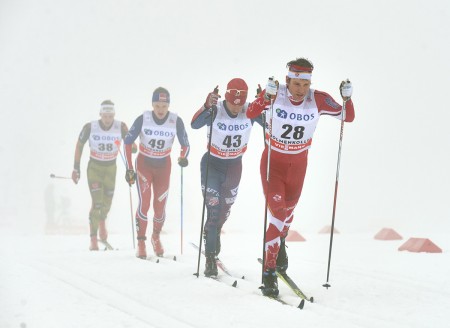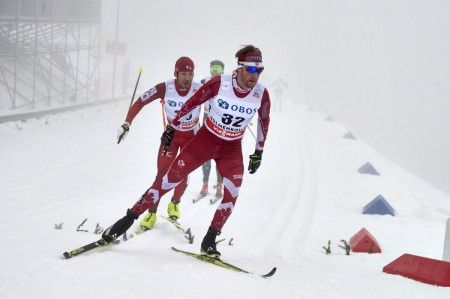
One one thousand. Two one thousand. Three one thousand. Four years ago, each of these seconds was a place, with skiers in the top 10 finishing within 10 seconds of the winner. Not the case for the men’s 50-kilometer classic mass start at the World Cup in Holmenkollen on Saturday in Oslo, Norway.
“It’s a battle from the start now. The days of skiing your way into the race are over. You have to be ready to hurt from the gun,” Devon Kershaw said on the phone after placing 23rd, 6 minutes and 8.8 seconds behind Norwegian winner Martin Johnsrud Sundby.
The 33-year-old Canadian believes that since the start of his ski racing career, changes have developed in the way these types of men’s distance races unfold.
“Before it would be kind of like bigger pack that would get whittled down to 20 or 30 people. That pack would be surging all the time,” he explained.
The major difference between the 50 k four years ago and this year’s mass start, according to a few North Americans, seemed to hinge on one factor: speed.
“Today the men raced like a women’s race. There was no dillydallying around in a pack. Even the first time climbing we were moving pretty quick,” American Scott Patterson, of Alaska Pacific University, wrote in an email.
In his third individual World Cup race, the 24-year-old Alaskan came close to his first World Cup points in 32nd, 8:47.8 behind the winner.
“It is a change from the 30-person sprint [to the finish] that you would have at times in the past,” the U.S. Ski Team’s leading distance skier, Noah Hoffman said on the phone. He placed 24th on Saturday, 0.7 seconds behind Kershaw and 6:09.5 behind Sundby.
“I actually think the change in the way guys are racing these probably helps me,” Hoffman added, “Because in a 30-person sprint, I’m very likely to finish 29th or 30th. So, for winning these races, I need to win it in the same way that Sundby does.“
Kershaw elaborated on the race-pace precedent currently being set by the leaders.

“[A] couple kilometers in and it’s already pressing at a strong, even pace. It’s not a surge. That’s just the pace you have to go for 46 k and if you can’t hack it, you blow up,” Kershaw said. “With Martin, he’s changed the way that men’s racing happens.”
Covering the 50 k in time of 2:08:41.9, Sundby won the event by 18.8 seconds over Norwegian teammate Niklas Dryhaug and 1:05.4 ahead of third-place finisher, Maxim Vylegzhanin of Russia.
Of course, that’s not to say that the pace is not maintainable, pending equipment, wax support and fitness.
Canada’s leading man on Saturday, Alex Harvey skied within the top 10 for the first 10.5 k, sitting in seventh at the 5 k mark, 1.5 seconds behind the race leader at the time, Norwegian Sjur Røthe.
“I felt like I should have been able to stay with the main group,” Harvey said in a post-race phone interview. “But when you’re losing so many positions in the downhills like that and then and trying to make your way back on the uphills in a 50 k … it’s frustrating.”
The Canadians have previously cited wax problems as a hindrance, and both Harvey and Kershaw said they were disappointed with their skis’ inability to keep up with the pace on Saturday. Harvey ended up 20th, 5:49 out of first.
“We’ve had a lot of problems this year with classic skiing, especially in wet klister conditions,” Harvey said.
With humidity hovering around 99 percent and a haze veiling racers from the spectators’ view on Saturday, Holmenkollen’s conditions were no exception.

Battling to stay at the front, Harvey dropped back to 20th and 29 seconds behind the leaders a fifth of the way through the race, about 12 seconds ahead of Kershaw and Hoffman in 23rd and 24th.
For the next 38 k, Kershaw and Hoffman pulled one another along, racing within a few seconds of each other.
Meanwhile, Harvey skied alone, about 20 seconds ahead of them, until around 30 k.
“Hoff and I pretty much skied the whole race together and we skied with Alex a lot of the race as well,” Kershaw said.
Hoffman said that while his recent World Cup performances have been consistent, an impending breakthrough is due.
“Either deliberately or not I’ve been racing pretty conservatively this season, which is good. It’s led to my most consistent season I would guess,” he said. “But I haven’t had a top 15 or a top 10 result that would really make the season. I think it’s there, I think it’s coming. Today was not the day. But I’m always happy to be back in the points.”
While Kershaw and Hoffman skied together throughout the remainder of the race to finish 23rd and 24th, respectively, Harvey managed to put a slight gap on the two within 1.2 k of the finish.
“His skis were a little better than mine coming down the last downhill,” Kershaw said.
Harvey trailed Norway’s Eirik Brandsdal into the finish (after skiing with Brandsdal for the last 10 k) and ended up 20th at the finish, about 20 seconds ahead of Kershaw and Hoffman.
“My strategy today was to stay near the front of the pack because I expected Martin to go out hard and try to break the pack early,” Harvey explained. “The goal is to relax for the first little bit [and] save energy for the end, but I was fighting really hard in the beginning just to stay in the group and not get dropped.”
He added, “I’m comfortable being in the back of the pack as long as I’m in the pack and not fighting just to stay in there, fighting against my skis.”
The third Canadian of the day, Graeme Killick finished in the points in 30th (+8:08.4). It was his second top 30 of the World Cup season after placing 21st in the skiathlon in early December in Lillehammer, Norway.

About 39 seconds after Killick, Patterson finished 32nd.
“While the conditions were a bit foggy, the skiing was actually quite good. The fog was a bit wet but held off from fully drenching us,” Patterson wrote after his first Holmenkollen experience. “ Other than a few times where I couldn’t see the group I was chasing, the limited visibility didn’t really make all that much of a difference.”
Mostly the visibility was worse for the spectators. It was the conditions that challenged the racers.
While Erik Bjornsen of the U.S. Ski Team started the race, he did not cross the finish line.
Racing up until the 6.8 k mark, Bjornsen sat in 27th, 17.2 seconds back from Sundby.
Not feeling in full form, Bjornsen did not re-enter the race course after stopping at the first of two permissible ski exchanges.
“My game plan was to go out and hang with the pack for as long as I could,” Bjornsen wrote in an email. “I have a lot of racing left on the itinerary so when I wasn’t feeling strong it made sense for me to drop out.
“I hate to have to make that call but it seemed like the right decision,” he added. “I’m hoping that decision will pay off next week where I have two of my favorite races on the schedule.”
With some 200-meters of climbing per 5 k, and six grueling ascents for each 8.6 k loop, the Holmenkollen mass start is certainly not a race many athletes choose to toy fancifully with.
“This course is really punishing, I mean, it is the most challenging on the World Cup,” Kershaw said.
Even with it’s unforgiving course and few hungry-for-more racers, the atmosphere of this year’s annual 50 k mass start struck just as strong as previous years’.
“You don’t know how many more years you get to race the Holmenkollen 50 k at my age,” Kershaw said. “While I’m disappointed in the result — very disappointed in the result — the experience is something that I’ll always take with me and it’s something that I think even as an older athlete, it’s not lost on me.
“It’s really special as a Canadian to be able to come to Norway and be able to race in such a fabled stadium with 50,000 to 60,000 screaming fans,” he added. “It makes you really love ski racing even if you’re having not the best day.”
Gabby Naranja
Gabby Naranja considers herself a true Mainer, having grown up in the northern most part of the state playing hockey and roofing houses with her five brothers. She graduated from Bates College where she ran cross-country, track, and nordic skied. She spent this past winter in Europe and is currently in Montana enjoying all that the U.S. northwest has to offer.



